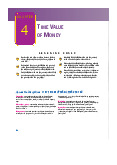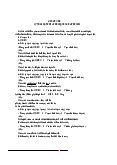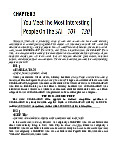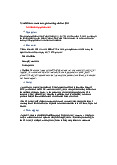

Preview text:
Rational Emotive Imagery Albert El is, Ph.D.
ational Emotive Imagery was invented in 1971 by Dr. Maxie Maultsby, Jr. and used effec-tively by him in his clinical
Rwork and that of his trainees. I found it to be quite useful but also found that it overlapped too much with REBT dis-putin
because Maultsby usual y had clients who did the imagery go back to their rational coping statements, which they h
previously figured out with him, and use them to change their inappropriate negative feelings when they thought about
unfortu-nate Activating Event or Adversity. I therefore began to use Rational Emotive Imagery in a more emotive-evocativ and less disputational way.
In Maultsby’s version, you imag-ine an unfortunate Activating Event (A) happening in your life — and let yourself
spontaneously feel very anx-ious or depressed at point C, a harm-ful Consequence of A. Then you look at your ratio
Beliefs (rBs) about A (e.g., “I don’t like my failing this task, but I can stand it and it doesn’t make me a complete failure”)
and you strongly say them to yourself, replacing your disturbance-creating irrational Beliefs. In doing this, you change yo
inappropriate feelings (Cl) to much more appropriate feel-ings (C2) of disappointment, regret or frustration.
To use the R EB T v ersion of Ra-tional Emotive Imagery (REI), pro-ceed as fol ows:
1. Imagine one of the worst things that might happen to you—such as failing at an important project, get-ting rejected
peopl e you rea l ly want to like you, or being in very poor health. Vividly imagine this un-fortunate Activating event or Ad
sity (A) occurring and bringing a string of problems into your life.
2. Let yourself deeply feel the kind of unhealthy, self-defeating fee -ling that you often experience when the unfortuna
Activating Event you are imagining actual y occurs. Thus, let yourself strongly feel—at point C, your emotiona
Consequence—very anxious, depressed, enraged, self-hating or self-pitying. Get in touch with this dysfunctional, happine
destroying feeling (Cl) and real y, real y feel it. Don’t prescribe the unhealthy feeling by tel ing your-self something like
“Now that I am imagining myself being treated badly, I should make myself feel very enraged,” because you may ac-tua
spontaneously feel panicked or depressed instead of enraged. So, as you imagine this bad Activating Event happening
yourself sponta-neously feel whatever you feel and not what you think you are supposed to feel at point C .l
3. Once you feel unhealthily up-set (at Cl) as you imagine this Ad-versity (A), hold this feeling for a minute or two—
again, real y, real y feel it—then work on your dysfunc-tional feeling until you truly change it to a healthy or self-helping
nega-tive feeling (C2). Which one? Wel , you can actual y prescribe an appro-priate negative feelin g (C2 ) that wil take
place of your inappropriate one (Cl). Thus, if you are enraged (Cl) at the image or visualization of people treating yo
unfairly (A), you can prescribe changing your rage to a healthy emotion of feeling very dis-pleased with and sorry abo
their acts, instead of enraged at and damn-ing them for these acts (C2). If you feel panicked (Cl) about your imag-ining y
are doing poorly at an im-portant job interview (A) you can change your panic to a feeling of real disappointment at ho
you are doing instead of horror at you for doing so badly (C2). You can also prescribe other healthy or self-helping negat
feelings, when you vividly imagine Adversities, such as sorrow, regret, concern, frustration and sadness (C2), instead
dysfunctional feel-ings of depression, terror, worthless-ness and fury (Cl) .
4. When you work at changing your feelings from sel -
f defeating to poten-tial y helpful negative emotions, be sure that y
do not do so by chang-ing the Activating Event or Adver-sity (A) that you are vividly imagin-ing. Thus, when you are
visualizing people treating you very unfairly and letting yourself feel unhealthily en-raged and h omicidal (C1) —un-health
because they wil obsess you and probably make you unable to deal adequately with this Adver-sity—you could instead m
your-self feel only distinctly displeased with these people’s behavior and not enraged at them (C2) by visualizing that th
are not real y treating you that unfairly or imagining that they have special “good” reasons for treating you that unfair wa
This, however, is incorrect use of REI. In doing Rational Emotive Imagery, make yourself keep the exact Ad-verse imag
(A) that you make your-self en-raged about and then w ork at changing your feeling to a healthy one.
5. Don’t merely use distraction tec -
h niques, such as relaxation, biofeed-back, or meditation methods to change y
unhea lthy, negative feel ings to healthy ones. Thu s, when you visual ize people rea l y treating you unfai rly (A) and you
your-self feel enraged about this (Cl), you could relax or meditate and thereby temporarily rid yourself of your rage. But b
doing so you would not be changing your underlying Beliefs (Bs) or philosophy about people’s un-fairness—such as , “Th
absolutely must not treat me in this unfair way! I can’ t stand their acting the way that they must no t! They are horrib le p
ple for acting this way and they de-serve to be damned and punished fo - r ever!” (iBs).
By using cognitive distraction techniques like relaxation or medita-tion, you wil shunt aside your people-hating
philosophy (iB) — but you wil not real y reduce it. Almost inevitably, you wil return to it the next time people treat you
unfairly and wil again enrage yourself at them. So if you want to at first relax and then go back to chang ing this unde rly hatred-creating philos -
o phy, fine. But don’t just stop with distraction m ethods. Go on to real Rational Emotive Imagery.
6. To do this, real y work at chang-ing your spontaneous disturbed Neg-ative feel ing (Cl) to a prescribed healthy Negat
feeling (C2)—such as sorrow, disappointment, regret, frustration, irritation or displeasure. How? By tel ing yourself—
strongly and repetitively—a sensible rational Belief (rB) or coping statement. For example: “Yes, they real y did treat m
shabbily and unfairly, which I wish they wouldn’t ha ve done. But there’s no reason why they must treat me fairly, howev
preferable that would be. Alas, that’s just not their wa y—and may never be! Too bad! T ough! But I can hate their behav
without completely damning them. And if I refuse to upset myself un-duly about their unfairness, I can perhaps show the
without deep anger, why I think they are unfair and perhaps get them to change. But if I can’t, I can’t. I’l just try to sta
away from people like that and give them little chance to keep treating me unfairly.”
7. I f you do Ration al Em otiv e Im-agery correc tl y, you’l usu a l ly f ind i t t a kes you only a fe w m i nute s t o change
self-sabotaging negative feelings (Cl) to healthy, self-helping ones (C2). Don’t give up! Persist! Remember that you creat
your own destruc-tive feelings of panic, depression, rage, self-hatred and self-pity (Cl). Yes, you—with your irrational Be
liefs. Therefore, you can always re-place them with healthy negative feel ings (C2) that wil help you deal with unfortun Activat-
ing Events (A’s) and then either change them or live a reasonably good life in spite of the m. So persist until you real y
the healthy negative feelings you are prescribing for yourself as a substi-tute for your self-damaging feeling.
8. Once you have made yourself feel less disturbed about the unfortunate Activating Events (A’s) that have happened
you—or that you have brought upon yourself—you can use Rational Emotive Imagery as wel to work on your seconda
feeling of disturbance. Thus, if you feel guilty and self-downing (Cl) about your rage at someone (A ), you can first vivid
imagine yourself continuing to create fury and temper tantrums, feeling spontaneously self-hating (if that’s how you rea
feel) about this visualization, and can hate yourself for a short while. Then change your self-talk and philosophy (B) so t
you only feel the healthy negative feelings (C2) that you prescribe for yourself about your self-defeating rage (A); e.g
make yourself feel only sorry and disappointed (C2) and not self-downing (Cl) as you very vividly imagine continuing t feel enraged.
9. You can fairly easily, at any given moment, use R EBT to create health y, instead of unhealthy, n egative feel -ings
unfortunate Activating Events in your life. But to use it ef-fectively, you usual y have to repeat it many times, such as 3
days in a row, for each unhealthy negative feeling you are trying to change. So if you real y work for a number of days
strongly imagining people treating you unfairly (point A) and if you forceful y work at changing your destructive feelings of
rage (at point C l, Consequence) to the healthy feelings of disappointment and regret (C2, your new Conse-quence), you
usual y find that when you thereafter imagine A, or when it actual y occurs in your life, you wil much more easily and
auto-matical y begin to feel the new healthy emotion (that is, C2, a new Consequence) rather than the for-mer, unheal one.
10. Rational Emotive Imagery, if repetitively done, thus becomes a useful REBT tool to train yourself more thoroughly t
feel health y, in-stead of unhealthy, n egative emo-tions when bad Activating Events en-ter your life. By consistentl y usin
you can change both your thinking and feeling habits and make yourself not only less disturbed, but eventu-al y le disturbable.
11. Give yourself the homework as-signment to do REBT at least once a day for several weeks to overcome a spec
dysfunctional feeling. If you find yourself carrying out this assign-ment regularly, you can reinforce yourself with some pleasure you re-al y enjo —
y such as reading, listening to music, jogging, or eating special food. If you fail to do regula
REI, you can penalize (but never damn!) yourself with something you find un-pleasant—such as cleaning, ironing, talk
to boring people or making a contribution to a cause you loathe. If you force yourself to do REI regu-larly, however—eve
when you find it unpleasant—you wil soon find the new emotional Consequences you keep achieving by its use quite warding.



